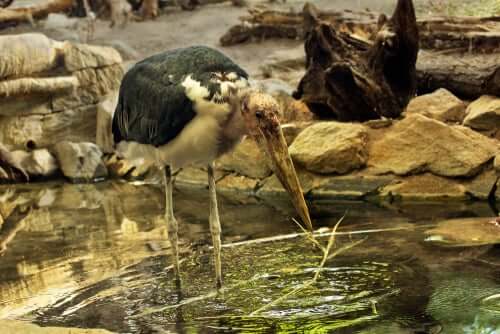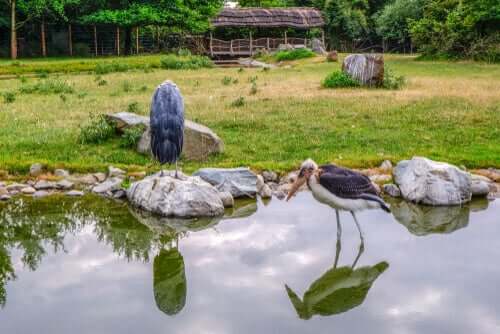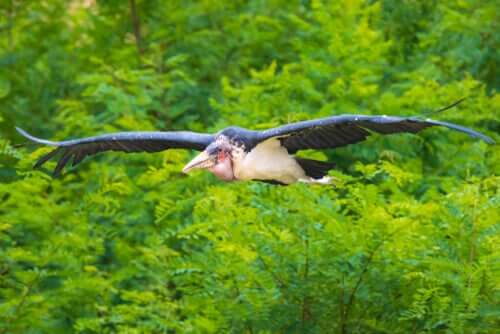The Marabou Stork: A Great Scavenger

The marabou stork is a carrion bird of the Ciconiidae family. In fact, they’re the largest member of this family and they’re also among the largest flying birds.
The Marabou stork inhabits tropical Africa, from Senegal to Eritrea, Ethiopia, Somalia, and including Namibia and South Africa. Its scientific name is Leptoptilos crumenifer and it’s an animal often spotted in aquatic and open semi-arid areas.
The species isn’t endangered and researchers suspect that their population is, in fact, increasing. This is mainly due to the availability of waste and carrion, which are their main food.
Characteristics and eating habits of the marabou stork
At almost three meters wide, the marabou stork is one of the largest flying birds in the world. This flying giant’s weight ranges from 13-20 pounds and they’re over 5 feet long. When standing with their legs completely straight they’re as tall as a human being.
Like most storks, marabous are gregarious but they’re rather moody. Also, they resemble other storks in that they’re very quiet. It’s only during the courtship rituals that they vocalize various sounds –they use their throat sac for this.
These kinds of storks are opportunistic. Thus, given the inadequacy of their beaks to dismember corpses, they must wait to take what other predators such as vultures discard.
Their animal diet is widely varied, they eat everything from birds, invertebrates, rats, and lizards. In addition, they’re experts at fishing who can catch anything on sight just by quickly dunking their partially opened beaks.
Their bad reputation

These scavengers are quite infamous because they supposedly eat smelly things and are too lazy or incompetent to catch their own prey.
However, hunting is simply one of the ways in which animals get food. In fact, there are many different scavenging species out there, including the regal lions, who won’t hesitate and will seize an opportunity if they see it. In any case, scavengers provide several unique and vital services for the maintenance of the ecosystem.
There are many advantages of scavenging for the ecosystem because the disposal of dead animals is no trivial matter. In fact, dead animals are a danger to the health of living animals because corpses are a source of many diseases.
This is why scavengers are so important, they can quickly and efficiently deal with the dead biomass and it greatly benefits our ecosystem. There’s a wide variety of scavengers out there: crows, vultures, and marabou storks among others.
A paradigm shift – the food web

Previously, ecologists thought that the food cycles within an ecological community were a linear process. Under such a scheme, they thought plants extracted nutrients from soils and sunlight, which would then go to the herbivores and would then would end up in carnivores. These food chains imply a considerable loss of energy in each transfer.
Now, experts use a food web-cycle perspective. In this scheme, the work of scavengers and decomposers within it are essential. This is because it encompasses all the food chains in the same ecosystem. That is, the food web-cycle accepts the fact that each organism living in an ecosystem participates in multiple food chains. This, in turn, increases energy efficiency.
The premise is that each food chain is a possible way for energy and nutrients to flow through the ecosystem. In the food web-cycle of an ecosystem, all food chains are interconnected and overlap.
All organisms in the food web-cycles are groups that fit into categories called trophic levels. In general terms, these levels subdivide into:
- The first trophic level: producers
- Then, the primary, secondary and tertiary level: consumers
- Finally, the last trophic level: decomposers.
Thus, it’s scavengers and decomposers who complete the biological life cycle. Their actions lead to recycling as the nutrients return to the soil or the oceans where the autotrophic organisms use them. Then, a new life cycle begins.
Advantages of scavenging for the marabou stork

The marabou storks, like most scavengers, are flexible about what they eat. This is an advantage, as it’s easier for them to eat when compared to creatures with a highly restricted diet.
Scavenging improves the adaptation of a species to new environments. This is definitely true in the case of the marabou stork, a species that’s now distributed throughout Sub-Saharan territory.
Though mostly sedentary, there are some nomadic populations of this stork. Some people have spotted them moving towards the equator after reproduction, and there are reports of them being in Morocco, Spain, and Israel.
The marabou stork often associates with humans and roams around their fishing villages and dumps. Their ability to eat a wide variety of foods is an important factor in its survival and, ultimately, in the success of other species that live in the areas they inhabit.
Thanks for reading.
All cited sources were thoroughly reviewed by our team to ensure their quality, reliability, currency, and validity. The bibliography of this article was considered reliable and of academic or scientific accuracy.
- Elliott, A., Garcia, E. F. J., & Boesman, P. (2014). Marabou (Leptoptilos crumenifer). Handbook of the Birds of the World Alive. In: del Hoyo, J., Elliott, A. Lynx Edicions, Barcelona.
- Bildstein, K. L., & Therrien, J. F. (2018). Urban birds of prey: a lengthy history of human-raptor cohabitation. In Urban Raptors (pp. 3-17). Island Press, Washington, DC.
- Zhang, Z., Huang, Y., James, H. F., & Hou, L. (2012). A marabou (Ciconiidae: Leptoptilos) from the Middle Pleistocene of northeastern China
